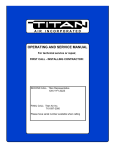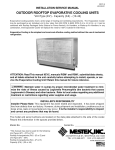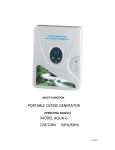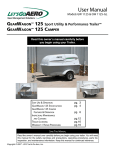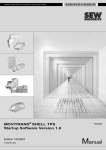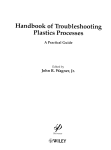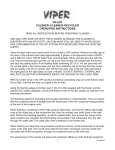Download OPERATING AND SERVICE MANUAL
Transcript
AIR INCORPORATED OPERATING AND SERVICE MANUAL Serial Number: _______ For technical service or repair, FIRST CALL - INSTALLING CONTRACTOR: WARRANTY 24 MONTH WARRANTY Titan Air, Inc. hereby warrants its products against defects in material and workmanship for a period of (24) twenty four months from date of shipment. Warranty sheet is due back within (30) thirty days of start-up for 24 month warranty to be effective. After (30) thirty days, and up until (60) sixty days, a (12) twelve month warranty will be observed. All warranties are null and void if warranty sheet is not received within (60) sixty days from start-up. NO EXCEPTIONS WILL BE MADE. Titan Air, Inc. reserves the right at Titan Air, Inc.’s option, to replace or repair free of charge, any part proven by Titan Air, Inc. to be defective. Prompt notification of defective part must be given to Titan Air Inc. and defective part must be returned freight prepaid within (30) days of notification. WARRANTY INCLUDES ONLY PARTS SUPPLIED BY TITAN AIR, INC. INCIDENTAL COSTS AND LABOR CHARGES SHALL BE THE RESPONSIBILITY OF OTHERS. This warranty does not cover fuses, belts, filters or water damaged parts. This warranty is void in event the product is improperly installed and/or operated under conditions other than normal published ratings, improperly maintained, misused or not in compliance with applicable codes: or not in accordance with Titan Air, Inc.’s operating instructions. This warranty is void if attempts to correct or repair any alleged defective part or parts are made by unauthorized personnel without Titan Air, Inc.’s written approval. In no event shall Titan Air, Inc. be held liable for any damage, incidental or consequential, arising from the installation, performance or operation of the product. This warranty supersedes, voids and/or is in lieu of any other verbal or written understanding which may not be in total accordance with this expressed warranty. Warranty parts must be returned to Titan Air Inc. within 60 days to receive credit. POTENTIAL FOR WATER DAMAGE DUE TO SUMP OVERFLOW Evaporative coolers installed in a location where sump overflow could cause damage to the building or other equipment must include safety feature #1 and either #2 or #3. Titan Air is NOT responsible for damages that could be caused by sump overflow. 1. Water supply piping must include a flow limiter to ensure that overflow outlet can drain more water than supply line can provide in the event that float valve fails. 2. A field installed overflow safety switch and fill/drain line valves. Install float switch to detect sump water levels slightly above the primary overflow inlet but, below the rim of the evaporative cooler sump. If the float switch actuates, automatic valves on the water supply line (normally closed) and drain line (normally open) must be de-energized. A secondary circuit provides alarm indication. 3. A secondary drain pan that will capture water in the event of a sump overflow and drain the water to an acceptable location. Secondary drain pan must be designed to handle full flow capability of supply line if float valve fails. PURPOSE / APPLICABILITY This manual is intended to provide general installation, operating, and service information. Reference materials for a specific evaporative cooler are included at time of shipment . Reference materials include Parts Lists, Electrical Schematic, Sequence of Operation, as well as pump and fill valve manufacturer’s documentation. Review the reference materials for a specific unit and note optional components which may not be addressed in this manual prior to start-up or service work. 1 EV OSM Rev 4.doc WARRANTY CHECKLIST Model: Serial No.: Titan Rep.: Date: Job Name: Address: Installing Contractor: Signature Fill in numbers and / or check applicable items (refer to installation instructions). Return a copy of this sheet to Titan Air to validate warranty. Warranty is void if this sheet is not properly filled-out and returned within 30 days of equipment start-up. NOTES AND COMMENTS PRESTART STATUS 120 V GFCI protected power by others Low level switch “piggyback” plug in GFCI receptacle. Pump plugged in to “piggyback” plug Fill, drain & overflow piped properly. No valves on overflow line and overflow pipe size never reduced. Fill valve and associated piping properly tightened. Float set and securely tightened. Fill/drain valves installed (if applicable) Optional controls wired properly Cooler level or slight pitch towards drain GENERAL OPERATION Fill level approx. ½” – 1” below media Fill level below overflow inlet Float operated fill valve shuts off completely. Low level float switch that powers pump is functional Pump functional Entire media wetted No water carry-over Powered fill & drain valves functional (if applicable) Low temp. drain stat (if applicable) Cooling stat (if applicable) Dry cycle (if applicable) Flush cycle (if applicable) Sump overflow safety features installed and tested if overflow could damage equipment or building. See page 1. 2 EV OSM Rev 4.doc TABLE OF CONTENTS WARRANTY Page 1 WARRANTY VERIFICATION CHECKLIST 2 GENERAL INFORMATION ¾ Equipment Arrival ¾ Components 4-5 INSTALLATION 6 OPERATION 7 WATER TREATMENT 8 MAINTENANCE 9 TYPICAL ASSEMBLY DRAWING 10 SPECIFIC UNIT INSERTS ¾ Parts Sheet ¾ Munters Info. ¾ Inspection Check List ¾ ABS Robusta Light Drainage Pump ¾ Little Giant ¾ KUUL Pads ¾ Munters Water Treatment Advice Note that operating and service manuals are occasionally requested prior to production of equipment. These manuals will be marked “Pre-Production Release” on the front cover. The final copy of the operating and service manual for a specific unit will be sent with the unit. 3 EV OSM Rev 4.doc GENERAL INFORMATION The information and recommendations contained in this publication are based on general observation and are not intended to supplant requirements of Federal, State, or local codes having jurisdiction. These codes should be reviewed before installation of Titan Air equipment. It is the responsibility of the purchaser at the time of order to specify any and all State, local, or insurance agency requirements that may dictate the addition of components to the equipment in order to comply with those requirements. Only qualified personnel who have experience with the installation and operation of industrial / commercial air handling equipment should attempt to install, start-up, or service Titan Air equipment. EQUIPMENT ARRIVAL A. When the transporter delivers the Titan Air equipment, be sure to inspect for damages. The equipment was thoroughly inspected before leaving the factory and the driver has signed for the equipment. Read the bill of lading and verify that the items listed are all present. Any damage or missing items should be reported to the transporter immediately. DO NOT SEND DAMAGED FREIGHT BACK TO TITAN AIR! All claims must be filed with the transporter. Be sure to take photographs and get the drivers signature to confirm the damage. The driver will have a number for you to call in order to file a claim. Request a written inspection report from the claims inspector to substantiate any necessary claim. Be sure to open the unit access doors and inspect for internal damage. If for some reason you are unable to install the equipment immediately, be sure that the equipment is protected from the elements. Water damaged parts are not covered by Titan Air’s warranty. If the equipment is stored for an extended length of time, be sure to completely check over the unit for any internal damage which may have been caused by excessive condensation. Fully lubricate bearings. Also, check for any damage caused by rodents and clean dust that may have built up on components. CAREFULLY AND THOROUGHLY READ TITAN AIR’S PRODUCT WARRANTY. B. Because we are not able to simulate exact field conditions and actual conditions can vary from the order, proper field start-up is essential. For this reason, start-up by a qualified technician is mandatory. The warranty checklist must be filled out while the start-up is accomplished. This checklist must be returned to Titan Air to validate the warranty. C. For a fee, Titan Air personnel will travel to the job site, supervise the start-up, and provide operation and maintenance training. EVAPORATIVE COOLING MEDIA Evaporative coolers are available with premium quality rigid, resin-reinforced cellulose media or fiberglass media (UL 900 Class II fire rated). The media is a crossfluted pad of cellulose or fiberglass material impregnated with anti-rot salts and rigidifying and wetting agents. Media transverse flutes form angles of 15° downward towards the air leaving side of the media and 45° downward towards the air entering side. Steeper flutes towards the air entering side of the media direct more water to the entering face where it is needed the most. Typical 12” deep media has an air pressure drop of 0.25" w.g. at 500 feet per minute face velocity and a saturation efficiency of 89%. 4 EV OSM Rev 4.doc GENERAL INFORMATION PUMP AND LOW LEVEL FLOAT SWITCH A submersible pump is placed in the evaporative cooler sump. A low water level switch is used to prevent the pump from running if the sump is not adequately filled. CABINET Titan Air evaporative cooler equipment features a stainless steel sump with a galvanized sheet metal cabinet above the sump. Complete stainless steel construction is optional. The galvanized sheet metal cabinet can be provided with a painted or galvanized finish. Standard painting process involves the use of galvanealled (paint lock), sheet metal with an acrylic enamel primer and finish coat. Custom painting processes are available to provide enhanced corrosion protection or color matching. 16 or 18 gauge sheet metal is utilized on exterior sheeting. Galvanized or galvanealled sheet metal features a zinc coating weight of G-90. Custom configurations with evaporative coolers incorporated into an airhandler or multiple coolers in an “air-house” are available. OPTIONAL CONTROLS Controls options include: 1. Automatic fill and drain valves. 2. Low ambient temperature drain thermostat to automatically drain sump. 3. Dry cycle (timer keeps blower running to dry media when unit is shutdown). 4. Flush cycle (runs pump with blower off to flush media followed by dry cycle). 5. Cooling thermostat (enables pump when space or outside air temp. rises). 6. Sump overflow safety switch & alarm (by others). 7. Supply line flow restrictor. Adjustable “circuit setter” type valve can be used. This flow restrictor is field set to ensure that supply flow cannot exceed drain capacity if float valve fails. 5 EV OSM Rev 4.doc INSTALLATION INSTALLATION 1. Titan Air evaporative coolers should be installed and maintained by experienced HVAC technicians. 2. When locating your Titan Air evaporative cooler, consider access requirements for inspection, maintenance and replacement of the components within the evaporative cooler (pump, fill valve, adjustment valves, media, etc.,). Evaporative cooler should be installed level or with a slight pitch towards the drain end. 3. Both the fill line and drain line should have shut-off valves installed at the cooler (do not valve the overflow line). Refer to the drawings for details regarding relative position of the media, fill valve, full water line, overflow standpipe, bleed line, and drain line. An automatic fill & drain system and/or automatic media flush/dry system are optional with your Titan Air evaporative cooler. 4. If the equipment is installed in a location where sump overflow could cause damage, overflow safety features must be field installed. Refer to page 1. 5. Fill line must be flushed PRIOR to connection to evaporative cooler. This cleans out debris that can prevent float operated fill valve from functioning properly. A water line filter is recommended to ensure proper operation of fill valve. 6. Drain and overflow lines must be properly trapped. In many cases, trap depth must account for the negative pressure (suction) in the evaporative cooler cabinet. Traps should be inspected and cleaned as part of a regular maintenance program. Overflow line size should not be reduced. 7. Inlet water pressure should be between 10 psi and 60 psi for proper fill valve operation. Fill valve height must be adjusted so that the water level shut-off point is approximately ½” to 1” below the media and slightly below the overflow inlet. After final water depth adjustment, confirm that all pipe fittings in fill valve line are secure, float adjustment is secure and that fill valve shuts off completely. Diaphragm in fill valve can be cleaned if fill valve does not shut-off completely. 8. A separate GFI protected, 120 VAC, 15 amp power circuit must be supplied for the evaporative cooler pump. Typically, the submersible pump plugs into a “piggyback” plug for a low water level switch to prevent the pump from running dry. If pump and low level float switch are factory wired, the “piggyback” plug may have been removed and both devices may be wired on the load side of a GFI module that does not accept standard plugs. 9. Typically, building air should not be recirculated over the evaporative cooler media. Recirculation can cause a build-up of moisture in the served area. The use of 100% outside air and building relief or exhaust is preferred. 10. Light on the media surface and sump water should be avoided. Light with moisture allows rapid growth of algae. 6 EV OSM Rev 4.doc OPERATION OPERATION 1. The fill valve float height and associated water level in the sump must be adjusted properly per step 7 above prior to energizing the GFI protected outlet for the low water level switch and pump. 2. While monitoring sump level to prevent spilling water over top of stainless steel sump, simulate failure of fill valve to allow water to continue flowing into sump and out of the overflow fitting. Adjust water supply line valves/fittings (by others) if necessary to establish a condition where supply flow cannot exceed overflow outlet capacity if float valve fails. 3. The low water level switch should allow the pump to be energized when the water level in the sump rises above 2.5” to 3.5”. 4. For new media, operate the pump without airflow for at least one hour to thoroughly rinse dust and excess resin from the media that accumulates in manufacturing processes. Drain the sump and re-fill prior to operating the pump with airflow. This will minimize any unusual odors that occupants might notice and also minimize foaming in the sump. 5. With the pump operating, adjust the main water flow rate hand valve to obtain a pressure of approximately 2 psi to 4 psi at the pressure gauge above the hand valve. Visually inspect the media on the upstream and downstream sides of the media. The entire media surface should be wetted without water carry-over into the airstream. If water is be entrained into the airstream, the air velocity across the media may be excessive and/or the water flow rate may be excessive. Obtain an air velocity reading and try reducing the water flow rate. Air velocity should not exceed 500 feet per minute without a drift eliminator. 6. A bleed line with adjustment valve allows a constant supply of fresh water for dilution of the recirculated sump water. See water treatment section below. Bleed-off rate must be set with the small hand valve on the bleed line. In addition to guidelines presented below, bleed-off rate should be adjusted based upon specific installation experience. 7. Operation of optional controls should be tested per sequence of operation. 8. A dry cycle (pump off with air flow on) of approximately 30 minutes is recommended following each pump operation. If the evaporative cooler and associated air supply cycle several times per day, only one daily dry cycle is needed. If scale build-up is a problem, the media should be flushed by allowing the pump to operate for one to two hours with no airflow. Follow this flush cycle with a dry down cycle. Timers and valves are available to automate the dry down and flush cycles. 7 EV OSM Rev 4.doc WATER TREATMENT WATER TREATMENT 1. Proper flow/bleed rates, routine maintenance/cleaning, and regular flushing/drying of the media and water distribution system are the most effective techniques for controlling scale build-up and biological fouling as well as extending media life. 2. In areas with poor water quality or areas where biological fouling particulates are present, consult with a water treatment specialist regarding chemical, ozone, or UV treatment of recirculating water. Water treatment guidelines are provided in Munters Engineering Bulletin EB-0111-WTM. Note that improper chemical treatment can damage the media. 3. The recommended pH of the water should be maintained at a level between 6 and 8. Exceeding these limits will deplete the resin content of the pad and thus reduce its structural integrity. Titan Air has had good success with a simple water treatment process involving a product called MARS Pan Protector. This is a water soluble time released biocide that will treat the recirculated evaporative water for up to three months. The product is effective against a broad range of mildews, molds, fungi, bacteria and viruses (including legionella bacteria). MARS Pan Protector is a safe time released product that will act as a chemical feeder for your system. It is EPA registered for safety and effectiveness. Insert the appropriately sized strip in the sump of your unit. Be sure not to interfere with the operation of the float assembly. The strip will time release active agents to kill and prevent microbial activity, reduce corrosion, and counteract odors. Replace the used strip every three months (it will be the same size as when installed), wrap in newspaper and dispose of in everyday trash. Wash hands after use. Note: The instructions that are printed on the MARS packaging are for air conditioner condensate drain pans. The product is distributed by Motors & Armatures, Inc. (800-445-4155). See the chart below for the appropriate sizing MODEL TA-24/24 EV TA-36/36 EV TA-36/48 EV TA-48/48 EV TA-48/60 EV TA-60/60 EV TA-60/72 EV TA-72/72 EV TA-72/84 EV TA-72 96 EV TA-72/120 EV CFM RANGE 1 ,000 to 2,000 2,000 to 4,000 3,000 to 6,000 5,000 to 8,000 8,000 to 10,000 10,000 to 13,000 13,000 to 16,000 16,000 to 18,000 18,000 to 20 ,000 20,000 to 22,000 22,000 to 30,000 8 MARS Pan Protector Part # 93285 93286 93287 93288 EV OSM Rev 4.doc MAINTENANCE INSPECTION/MAINTENANCE 1. Regular inspection and maintenance of the evaporative cooling equipment will ensure proper service and efficiency from the equipment for years. Establish a routine inspection and maintenance program for the evaporative cooler. A sample inspection sheet is included with the materials shipped with each evaporative cooler. 2. The media and water distribution system should be visually inspected on a regular basis and cleaned or repaired as necessary. Water distribution manifold holes can become plugged with debris resulting in uneven water flow and scale formation. If the media needs replacement, ensure that the new sections are oriented properly (see bulletin 805-OI included with the materials shipped with each evaporative cooler). 3. For significant scaling problems, verify proper water distribution across media face, increase water flow rate, reduce the number of on/off cycles, increase bleedoff rate, or use chemical treatment. For significant algae or biological fouling, completely dry the pads at least once per day, flush the sump, minimize sources of light and nutrients, and/or use chemical, ozone, or UV water treatment. 4. Properly maintained and operating media will help minimize distribution of airborne contaminants. With proper water distribution, the media acts as a selfcleaning filter. 5. Confirm complete shut-off of float operated fill valve. 6. Clean drain line/trap and overflow line/trap. If equipment is installed in a location where sump overflow could cause damage, test operation of overflow safety features. 9 EV OSM Rev 4.doc TYPICAL ASSEMBLY DRAWING 1. 10 EV OSM Rev 4.doc 11 EV OSM Rev 4.doc 12 EV OSM Rev 4.doc 13 EV OSM Rev 4.doc 14 EV OSM Rev 4.doc 15 EV OSM Rev 4.doc 16 EV OSM Rev 4.doc 17 EV OSM Rev 4.doc 18 EV OSM Rev 4.doc 19 EV OSM Rev 4.doc 20 EV OSM Rev 4.doc 21 EV OSM Rev 4.doc 22 EV OSM Rev 4.doc 23 EV OSM Rev 4.doc 24 EV OSM Rev 4.doc 25 EV OSM Rev 4.doc 26 EV OSM Rev 4.doc 27 EV OSM Rev 4.doc 28 EV OSM Rev 4.doc 29 EV OSM Rev 4.doc 30 EV OSM Rev 4.doc 31 EV OSM Rev 4.doc 32 EV OSM Rev 4.doc 33 EV OSM Rev 4.doc 34 EV OSM Rev 4.doc 35 EV OSM Rev 4.doc 36 EV OSM Rev 4.doc 37 EV OSM Rev 4.doc 38 EV OSM Rev 4.doc







































